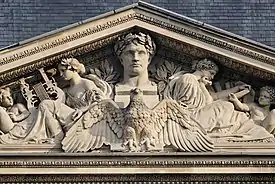
Pierre-Charles Simart; after
a bust by Francisque Duret
a bust by Francisque Duret

Pediment at the Pavillon de l’Horloge, Louvre, Paris
Pierre-Charles Simart (born in Troyes on 27 June 1806, died in Paris on 27 May 1857) was a French sculptor.
The son of a carpenter from Troyes in Champagne, Simart was the pupil of Antoine Desbœuf, Charles Dupaty, Jean-Pierre Cortot and James Pradier. In 1833, he won the first Prix de Rome for sculpture with a relief Le Vieillard et les enfants.
He was an elected member of the Académie des Beaux-Arts in 1852.
Main works
- La Poésie épique, statue, marble, Paris, Jardin du Luxembourg
- La Philosophie, statue, marble, Paris, Jardin du Luxembourg
- pediment of the Pavillon de l’Horloge, Louvre, Paris, with fellow sculptor Antoine-Louis Barye, 1857
- Statue of Napoleon in coronation robes and reliefs of Napoleon's achievements, Napoleon's tomb at Les Invalides, Paris
- a chryselephantine (gold and ivory) recreation of the Athena Parthenos originally by classical sculptor Phidias, for patron Honoré Théodoric d'Albert de Luynes
- four Hellenic friezes and ten reliefs at the Château de Dampierre, for architect Félix Duban, 1841–1843
References
- (in French) Emmanuel Schwartz, Les Sculptures de l'École des Beaux-Arts de Paris. Histoire, doctrines, catalogue, École nationale supérieure des Beaux-Arts, Paris, 2003
Wikimedia Commons has media related to Pierre-Charles Simart.
External links
- (in French) Works by Simart, on Insecula.com
- (in French) Works by Simart, on Base Joconde
This article is issued from Wikipedia. The text is licensed under Creative Commons - Attribution - Sharealike. Additional terms may apply for the media files.